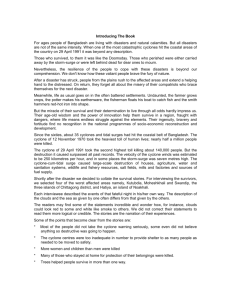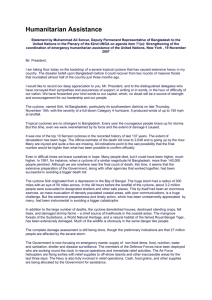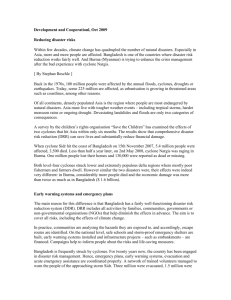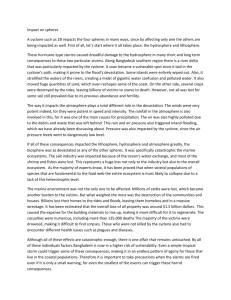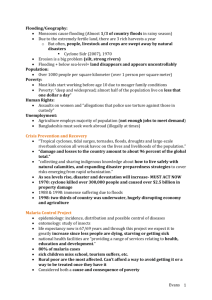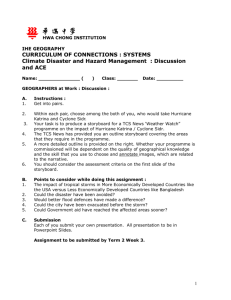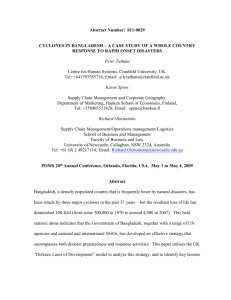Terms of Reference
advertisement
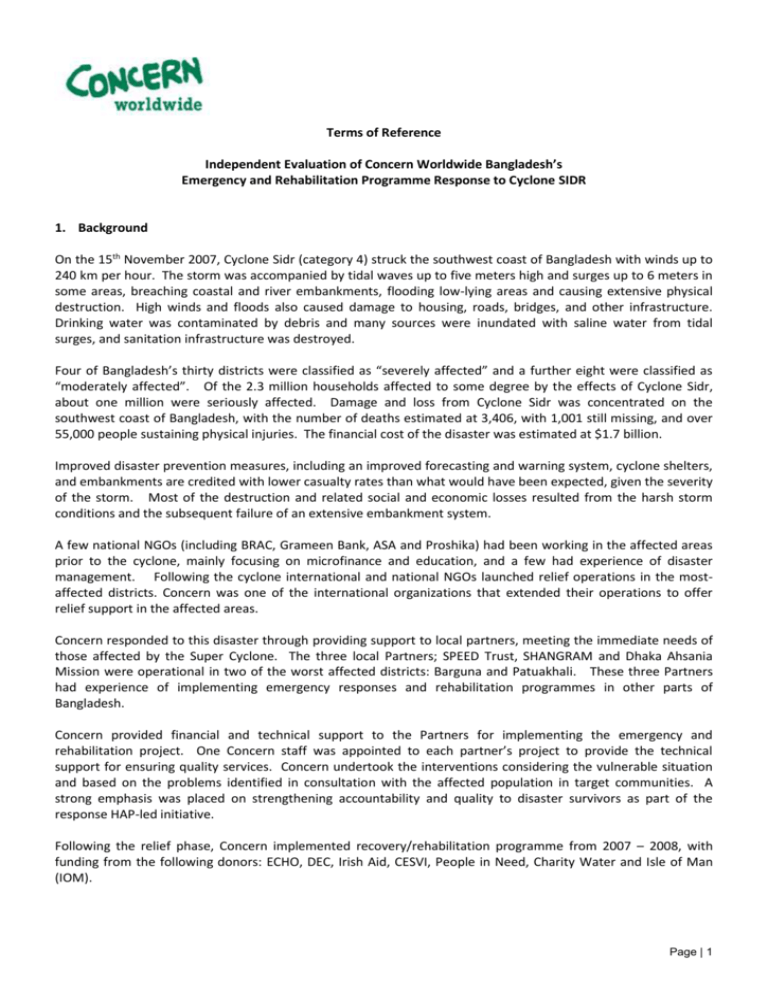
Terms of Reference Independent Evaluation of Concern Worldwide Bangladesh’s Emergency and Rehabilitation Programme Response to Cyclone SIDR 1. Background On the 15th November 2007, Cyclone Sidr (category 4) struck the southwest coast of Bangladesh with winds up to 240 km per hour. The storm was accompanied by tidal waves up to five meters high and surges up to 6 meters in some areas, breaching coastal and river embankments, flooding low‐lying areas and causing extensive physical destruction. High winds and floods also caused damage to housing, roads, bridges, and other infrastructure. Drinking water was contaminated by debris and many sources were inundated with saline water from tidal surges, and sanitation infrastructure was destroyed. Four of Bangladesh’s thirty districts were classified as “severely affected” and a further eight were classified as “moderately affected”. Of the 2.3 million households affected to some degree by the effects of Cyclone Sidr, about one million were seriously affected. Damage and loss from Cyclone Sidr was concentrated on the southwest coast of Bangladesh, with the number of deaths estimated at 3,406, with 1,001 still missing, and over 55,000 people sustaining physical injuries. The financial cost of the disaster was estimated at $1.7 billion. Improved disaster prevention measures, including an improved forecasting and warning system, cyclone shelters, and embankments are credited with lower casualty rates than what would have been expected, given the severity of the storm. Most of the destruction and related social and economic losses resulted from the harsh storm conditions and the subsequent failure of an extensive embankment system. A few national NGOs (including BRAC, Grameen Bank, ASA and Proshika) had been working in the affected areas prior to the cyclone, mainly focusing on microfinance and education, and a few had experience of disaster management. Following the cyclone international and national NGOs launched relief operations in the mostaffected districts. Concern was one of the international organizations that extended their operations to offer relief support in the affected areas. Concern responded to this disaster through providing support to local partners, meeting the immediate needs of those affected by the Super Cyclone. The three local Partners; SPEED Trust, SHANGRAM and Dhaka Ahsania Mission were operational in two of the worst affected districts: Barguna and Patuakhali. These three Partners had experience of implementing emergency responses and rehabilitation programmes in other parts of Bangladesh. Concern provided financial and technical support to the Partners for implementing the emergency and rehabilitation project. One Concern staff was appointed to each partner’s project to provide the technical support for ensuring quality services. Concern undertook the interventions considering the vulnerable situation and based on the problems identified in consultation with the affected population in target communities. A strong emphasis was placed on strengthening accountability and quality to disaster survivors as part of the response HAP-led initiative. Following the relief phase, Concern implemented recovery/rehabilitation programme from 2007 – 2008, with funding from the following donors: ECHO, DEC, Irish Aid, CESVI, People in Need, Charity Water and Isle of Man (IOM). Page | 1 Donor Name: Irish Aid EHAF People in Need Isle of Man (IOM) Phase Main Activities Rescue and relief Funding Details Distribution of Food and non food items ECHO ECHO ECHO CESVI Charity Water DEC Disaster Response Plan (DRP) DEC Extended Response Programme (ERP) Recovery and Rehabilitation ECHO Shelter materials, water supply (DTWs and PSFs), cash for work, livelihood assets (fishing boats) Funding Contract Contract Details (IG469) CON0718 (PS033) Alliance Partner Concern UK ECHO/BDG/BUD/2007/010 02 ECHO/BDG/BUD/2007/030 05 ECHO/BDG/BUD/2007/040 02 ECHO/BDG/BUD/2008/010 01 (EC050) (EC049) (EC055) (EC056) 10/12/2007 10/5/2008 2007 2007 17/11/2007 (3 months) 10/12/2007 (6 months) 1/2/2008 (6 months) Concern US 15/4/2008 (6 months) 1/2/2008 – 31/7/2008 11/2/2008 DEC Form 5 1/9/08 - 28/2/09 DEC Form 5 1/9/08 – 28/2/09 Alliance Partner (DC014) Timeframe 2. Purpose and Overall Objective of the Evaluation a. The purpose and overall objective of the evaluation is to conduct an independent, external evaluation on the appropriateness, effectiveness and performance of the combined interventions, through all stages of the project cycle and assess Concern’s commitment to accountability and programme quality, using relevant OECD-DAC evaluation criteria, as primary points of reference. b. Analyse the various phases of the intervention to capture lessons learnt and demonstrate how and where application of learning was applied and integrated into the various stages of the intervention by Concern and its partners. c. The evaluation will also provide an opportunity to document and develop valuable lessons learnt to inform Concern and its partners the extent to which organisational strategies were met. In addressing these issues, the evaluation will draw out lessons learnt and examples of best practice in “what has worked well” and “what has not” in order to improve future emergency interventions and strengthen emergency preparedness capacities in order to help communities, partners and Concern better cope with risk and future appropriate responses to disaster and crisis within and outside Bangladesh. Specific Objectives: areas according to OECD-DAC evaluation criteria should examine the following: Evaluate the Efficiency of implementation in terms of resources and approach? Was Concern’s response timely, appropriate and cost effective and to what extent did Concern and the partners have the capacity, systems and procedures, sufficient human resources and appropriate level of preparedness to facilitate a rapid and appropriate response? Identify strengths and gaps in Concern’s structure, staff skills, capacity and systems for an effective response considering the scale and magnitude of the emergency. Comment on the Human resources and management systems, the challenge of expansion from a development–focused base. Mechanisms used in recruiting or transferring staff. Implications for the organization of the nature of the staff in the short, medium and longer terms. Inter-agency competition/sharing of staff. Examine the Effectiveness of the emergency relief and rehabilitation programmes undertaken and of the M&E system and the appropriateness of indicators. Page | 2 Assess the Relevance of the intervention and appropriateness of methodologies used and assess coherence and co-ordination, and the extent and effectiveness of coordination between Concern and other international NGOs, the UN system and government organizations. Examine the Connectedness & Coherence of the response, did the short-term emergency activities, take into account longer-term and interconnected problems i.e, DRR. Was there consistency in policies and practices to take into account humanitarian and human rights considerations and how did Concern perform against international and technical standards to which the organisation aspires and the extent to which the Sphere and Humanitarian Accountability Principles (HAP) standards were applied. Additional relevant strategic issues for Concern for the Evaluation to include: Evaluate if appropriate mechanisms were developed at the local level to enable affected communities to actively participate in the response and to articulate their grievances and concerns. Comment on the Community responses and participation modes in different phases, building, maintaining and strengthening community capacity. Community structures, the nature of need assessment at different levels & stages, prioritization of needs and communities’ involvement in overall design, implementation, and assessment process. Did the interventions address specific vulnerabilities and limitations on women and where there specific activities for women, and other groups with special needs. What special efforts were taken to address the needs of vulnerable groups and expanding benefits to them? Was HIV and AIDS considered or addressed at an in any stages in the responses? What lessons were learnt in terms of partnership with regard to: needs assessment, meeting immediate needs of disaster survivors, funds management, and future disaster risk reduction? The nature, quality, and actual mode of operation of partnerships Scope of Work, the work itself will include the following activities; Collection of relevant secondary data i.e., case studies, proposals, donor reports, Emergency Unit field trip report, workshop minutes, learning papers, HAP minutes and case studies, internal audit reports and country annual reports; Use of appropriate tools and interview/focus groups questionnaires (guides); the process should be participatory to the extent possible and should involve all stakeholders in the project; Use of an appropriate participatory methodology for the evaluation; Visit to the areas where the emergency responses were implemented, using appropriate tools to interview programme participants and other key stakeholders, including partners and project staff; Presentation of the findings to the Bangladesh country team and partner organisations in a workshop (30-minute presentation, max 20 slides, 60-minute question and answer session); Produce and solicit feedback on the draft report from the country team; Produce the final report from the analysis (both primary and secondary), maximum 25 pages, plus annexes). The report should include a clear and concise Executive Summary of no more than 3 pages. Page | 3 3. Outcomes, The analysis and evaluation report should focus on key themes: The Efficiency of Concern and the partners in addressing humanitarian needs through the intervention. The application of learning across the intervention throughout the various phases Identification and distillation of valuable lessons both good and bad to inform future implementation of Concern’s Emergency Programmes Clear and concise recommendations for any modification in existing approaches, interventions, and indicators, structure, management and M&E of Concern’s Emergency Programme 4. Evaluation Team The Evaluation Team will consist of two external consultants, 1 International as Lead Consultant and 1 National as a counterpart. Concern will also form a small team comprising of staff from partners and Concern staff to support the lead consultant. The lead consultant will be responsible for the overall management of the evaluation and completing the evaluation as per these Terms of Reference. 5. Timing A total of 15 working days, of which 12 days must be spent in Bangladesh by the Lead Consultant. The 15 days is also inclusive of time for producing the final report, to be submitted no later than 20th December 2009. 6. Reporting The Evaluation Team will report to the ACDS in the first instance but is accountable to the Country Director, providing regular updates on the progress of evaluation to the Concern and its partners’ senior management. The report will be submitted to the Country and Regional Director and shared between members of Concern Bangladesh as appropriate. Page | 4
